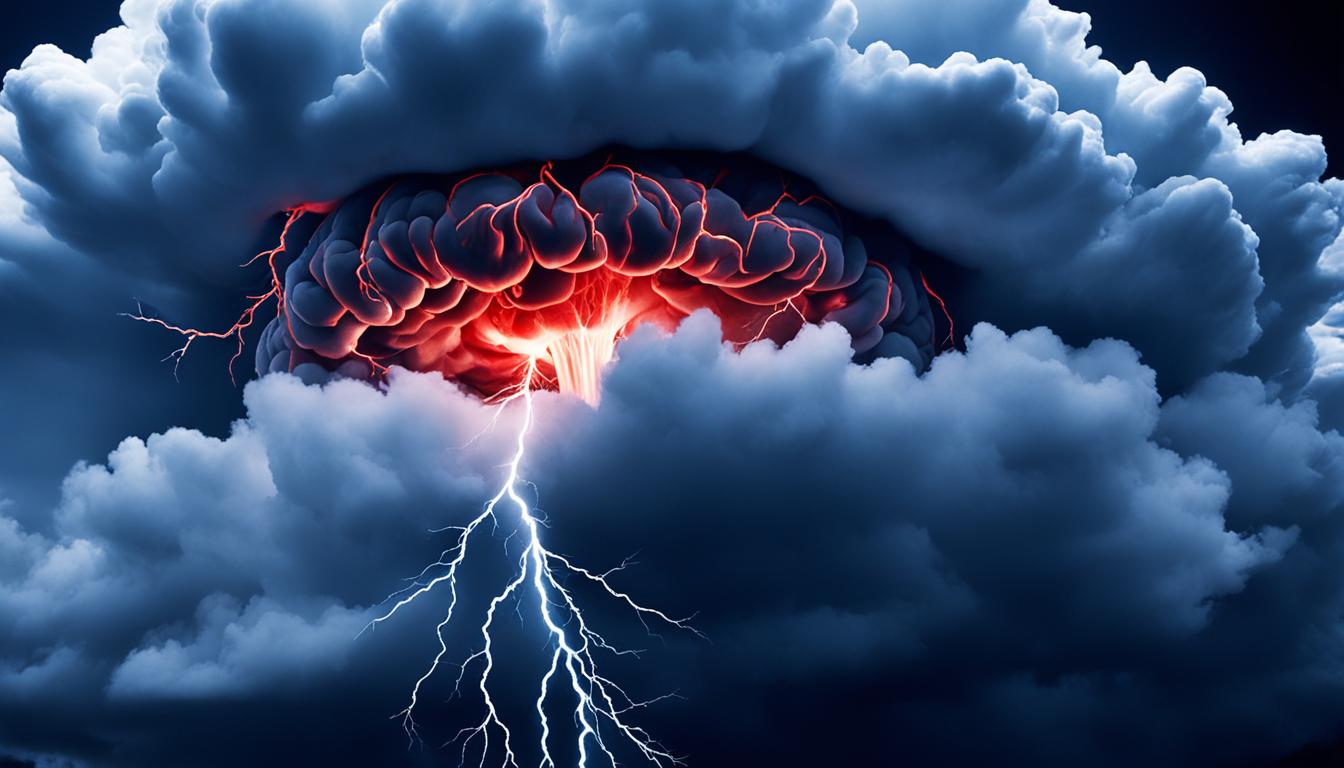A brain bleed, or intracranial hematoma, is a serious stroke type. It happens when blood gathers between the brain and the skull. This reduces oxygen flow to the brain. It’s a life-threatening issue needing quick action for the best chance of recovery.
Signs of an intracranial hematoma include a sudden headache, feeling confused, and numb on one side. Causes range from injuries to ongoing medical conditions. High blood pressure, certain medicines, and bleeding disorders can also lead to this condition.
Diagnosis often involves scans like CT or MRI to see the bleed. Treatment may require surgery, medicines, or rehab. The outcome varies based on how quickly and how well the treatment is done.
Recently, stem cell therapy has shown promise in treating intracranial hematoma. Research indicates that stem cells help the brain heal and grow new tissue.
Key Takeaways:
- Intracranial hematoma can be life-threatening, blocking oxygen to the brain.
- Hallmarks include sudden headache, confusion, and feeling numb on one side.
- Causes range from injuries to ongoing health issues and medication factors.
- Diagnosis often involves advanced imagery like CT or MRI scans.
- Treatments include surgery, medication, and therapies like rehab.
- Stem cell therapy shows promise in aiding recovery and brain tissue growth.
Symptoms and Diagnosis of Intracranial Hematoma
The signs of intracranial hematoma can change based on where and how big the bleed is. You might get a sudden, strong headache or feel sick to your stomach. Some people feel confused, dizzy, or have seizures.
A limb could become weak or numb on the side of the body near the bleed. These signs could start right after hitting your head or slowly get worse.
Doctors figure out if you have intracranial hematoma by checking your body and asking about your past health. They also use special tests like CT scans and MRIs. These tests show where the bleed is and how bad it is.
Doctors might also do a lumbar puncture. This means they check fluid around your spine for signs of the bleed or other issues.
Causes and Treatment of Intracranial Hematoma
Intracranial hematoma is bleeding between the brain and skull. This can happen from head injuries, especially those causing fractures or injury to vessels. Other factors include high blood pressure, blood disorders, and certain medications like blood thinners.
Treating intracranial hematoma depends on its size, location, and how severe it is. If bleeding is small, doctors might just watch it and help with any discomfort. But severe bleeding causing neurological issues might need immediate surgery to relieve brain pressure.
Durning surgery, the aim is to avoid further damage and aid recovery. Neurosurgeons remove the clot and fix any damaged vessels to improve blood flow. This surgery can be life-saving and improve how patients with this condition will do.
Besides surgery, doctors might suggest medications to ease symptoms and prevent complications from hematoma. Drugs to reduce pain or seizure prevention drugs are common. The right medication will depend on the patient’s condition.
Stem cell therapy is an exciting new avenue for treating intracranial hematoma. This treatment uses stem cells to repair damaged tissues. It may help patients recover better and improve neurological functions.
Yet, stem cells for intracranial hematoma are still under study. More research is needed to find the best way to use this therapy. But it’s promising, offering a chance for better recovery and life quality for patients.
| Treatment Options for Intracranial Hematoma | Benefits | Potential Risks |
|---|---|---|
| Surgery | – Immediate removal of blood clot – Relieves pressure on the brain – Reduces the risk of further damage |
– Surgical risks, such as infection or bleeding – Potential complications related to anesthesia |
| Medication | – Manages symptoms such as pain and seizures – Prevents complications |
– Potential side effects of medication – Individual response may vary |
| Stem Cell Therapy | – Potential for tissue repair and regeneration – Improved neurological functions – Enhanced recovery outcomes |
– Early stage of research and development – Optimizing dosing and delivery methods – Long-term efficacy and safety |
Stem Cell Therapy for Intracranial Hematoma
Stem cell therapy is a new hope for those with intracranial hematoma. This therapy uses special cells that can change into other cell types. They might help fix brain tissue. Many studies show promise in improving how well people function and their recovery from this condition.
The cells come from places like bone marrow, umbilical cord blood, and fat tissue. After getting these cells out, doctors put them where they are needed. This might help heal the damaged brain. Though it’s early in research, early results are encouraging. They hint at a new way to treat intracranial hematoma.
We still need more research to know the best way to use stem cells for this. Scientists are working hard to uncover all the benefits of this therapy. There’s a chance it could change the way we help people with this type of brain injury. Stem cell therapy offers a glimpse of hope, with its potential to boost healing and recovery.

